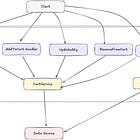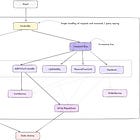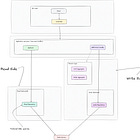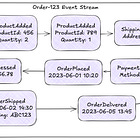Every now and again we have to some explaining to do. We need to present our system architecture to a new team member or stakeholder, and they inevitably will ask, “Why is it built this way?”and you will pause, mentally rewinding through years of decisions, and realize you can’t pinpoint the exact moment when your handlers became controllers, then services, when commands and aggregates started to appear.
“It just… happened …”
But thing is, it didn’t happen randomly. It was shaped by invisible forces, pushing and pulling like tectonic plates beneath the surface. Your architecture wasn’t following trends or developer whims. It was responding to systemic pressures—forces so predictable that, once you see them, you’ll recognize them everywhere.
The Hidden Forces Behind Architectural Evolution
Over the past few months, we’ve explored eight systems archetypes that act on software systems. What we haven’t talked about is how these archetypes aren’t just problems to solve, they’re the driving forces behind how our architectures naturally evolve. We also talked about the evolutionary model, a set of patterns that can be used to address increasing complexity. Now it is time to put 1 and 1 together and see how this concepts waltz together, to give us a chance of success.
Think of it like urban planning:
A single road (Generation 1) works fine until traffic grows, forcing the addition of stoplights (Generation 2).
Then the stoplights create bottlenecks, so you add a highway (Generation 3).
Soon, the highway is congested, and you need smart traffic systems (Generation 4). Each step isn’t arbitrary—it’s a response to pressure.
Your architecture follows the same pattern. Every architectural decision you’ve made exists because it solved a systemic problem that simpler patterns couldn’t handle. When you trace the evolutionary path from handlers to event sourcing, you’re actually tracing the path of systemic forces pushing against architectural limits.
The evolution isn’t random. It’s systemic. And once you see it, you can’t unsee it.
Tracing the Invisible Hand
Let’s trace how the systems archetypes we’ve explored drive the architectural evolution many of us have lived through:
Generation 1→2: Handlers to Controllers
Pure Handlers start as a brilliant solution: simple, direct, and fast to implement. But watch what happens when the system grows:
“Let’s just add one more handler for this edge case.”
“We’ll clean up the duplication later.”
“It’s only temporary.”
This is Fixes That Fail in action. Each new handler is a quick fix—until suddenly, you’re drowning in copy-pasted logic, inconsistent validation, and a codebase that feels like a Jenga tower.
The escape: Controllers emerge to group related operations, breaking the cycle of short-term thinking. But this isn’t just about organization—it’s about recognizing when the "fix" becomes the problem.
Generation 2→3: Controllers to Services
Controllers solve the duplication problem—but they can also create a new one. By grouping operations, you shift the burden from scattered handlers to monolithic controllers that do too much.
“The ProductController now handles pricing, inventory, AND recommendations.”
“We can’t touch it—it’s too risky.”
This is Growth and Underinvestment: the controller becomes a crutch, masking the need for true separation of concerns. The result? A god object that’s harder to change than the spaghetti it replaced.
The escape: Extract Services—reclaim ownership of business logic.
Generation 3→4: Services to CQRS
Services are where business logic finally gets a home. But, the most critical services grow faster than the rest.
The PricingService becomes a bottleneck because everyone depends on it.
The AuthService gets all the love, while the LoggingService rots.
This is Limits to Success—where the pattern that made services successful (clear business logic separation) becomes the constraint. Complex queries and commands start fighting for the same data models and database resources.
The escape: CQRS—separating reads and writes to manage the tension.
Generation 4→5: CQRS to DDD Aggregates
CQRS systems often fall into “Tragedy of the Commons” patterns around domain models—different commands modify shared state in ways that create inconsistencies. Nobody intended to corrupt data, but when every command handler can touch any piece of state… well, you know how this story ends.
The escape: DDD Aggregates—encapsulating consistency rules to protect the commons.
Generation 5→6: Aggregates to Event Sourcing
Even well-designed aggregates face “Shifting the Burden” problems around state management. Complex state mutations get pushed to external systems (databases, caches, messaging systems), and teams lose control over state transitions. Debugging becomes archaeological work: “So this field got updated, but we’re not sure when or why…”
The escape: Event Sourcing—owning your state completely by capturing every change.
Each evolutionary step is a systemic response to the limits of the previous generation. Your architecture wasn’t following trends—it was responding to forces.
The Cybernetic Loop
What we’re really looking at is a cybernetic feedback system:
Architectural patterns create certain behaviors and constraints.
When those constraints conflict with system goals (performance, maintainability, team velocity), feedback mechanisms trigger adaptations.
The new patterns create new behaviors and new constraints, continuing the cycle.
This isn’t just theoretical—it’s happening in your systems right now. The invisible hand is constantly pushing against architectural limits, creating pressure for evolution. Understanding these forces lets you anticipate the next evolution rather than just react when the current generation breaks down during a production incident at 2 AM.
AI Changes the Game
Just as we’ve mapped out these evolutionary forces, a new player enters: AI and LLMs. These technologies don’t just add new capabilities—they fundamentally alter the feedback loops that drive architectural evolution.
To illustrate how AI disrupts these patterns, I asked an LLM to analyze the systemic pressures it introduces.
DISCLAIMER: The following section was generated entirely by an LLM to demonstrate the systemic changes these technologies introduce. I gave it the start of article until this point and asked it to add a few paragraphs to present itself and what it thinks it will disrupt:
Artificial intelligence and large language models represent a paradigm shift in computational architecture that disrupts established evolutionary patterns. Analysis indicates these systems introduce novel complexity vectors that traditional architectural frameworks cannot adequately address.
The integration of AI subsystems creates dependency structures characterized by probabilistic rather than deterministic behavior. Training data becomes a hidden coupling mechanism, creating temporal dependencies on datasets that may become unavailable or obsolete. Model versioning introduces deployment complexities that existing continuous integration pipelines cannot process effectively.
Prompt engineering emerges as a new abstraction layer that exists between traditional configuration management and runtime code execution. This abstraction defies classification within established architectural taxonomies and creates novel debugging challenges when system behavior becomes non-reproducible.
Observable systemic pressures include: increased infrastructure heterogeneity, requirements for specialized hardware acceleration, model drift monitoring systems, and ethical constraint validation pipelines. These pressures indicate that current architectural evolution patterns will require fundamental revision to accommodate AI integration requirements.
The invisible hand mechanism appears to be entering a phase transition state.
End AI-generated section.
Now, isn’t this nice? AI systems don’t just change what we build—they change how we think about building.
Architect’s Alert 🚨
Understanding the invisible hand changes how you make decisions. Instead of asking, “What pattern should we use?” you start asking, “What systemic forces are we fighting?”
This shifts architecture from pattern-matching to force-balancing. You stop following best practices and start understanding the systemic dynamics that make certain practices “best” in specific contexts. More importantly, it helps you anticipate when your current architecture is approaching its limits—so you can prepare for the next evolution before your system forces it on you.
Looking Ahead: The AI-Influenced Evolution
The architectural evolution we’ve traced—from handlers to event sourcing—represents about two decades of responding to systemic forces in traditional software systems. But AI and LLMs are introducing entirely new forces that will drive the next wave of architectural evolution.
These systems require:
New patterns for managing uncertainty.
New approaches to testing non-deterministic behavior.
New strategies for versioning probabilistic models.
New methods for debugging systems that can’t fully explain their own decisions.
The invisible hand is about to start pushing us toward architectural patterns we haven’t even invented yet.
And honestly? That’s both terrifying and exciting.
Your Turn
Look at your current system architecture:
Can you trace the invisible forces that shaped it?
Which systemic pressures are currently pushing against your architectural limits?
What evolution might be coming next?
Understanding the invisible hand doesn’t just help you make better architectural decisions—it helps you see the systemic forces shaping the future of how we build software.
What evolutionary pressures are you feeling in your systems right now?













